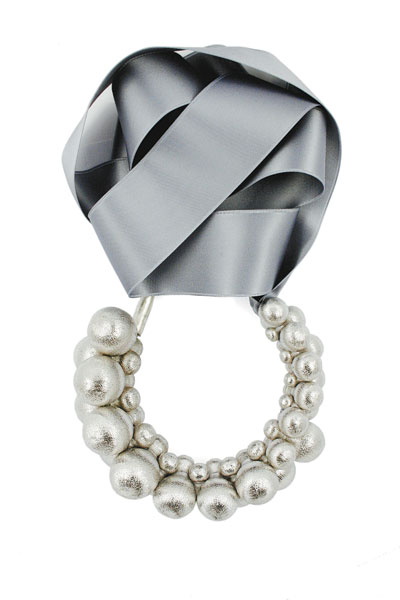|

Cao Zhen
caozhen0806@126.com
RARELY does Shenzhen hold contemporary jewelry design exhibitions at modern galleries, even though the city is regarded as the jewelry manufacturing and wholesale hub of China. However, there currently is a jewelry exhibit at OCT-LOFT, displaying works of three generations of artists from the Netherlands.
“Triple Parade” features works by Gijs Bakker (born 1942), Lucy Sarneel (born 1961) and China-born Sun Jie (born 1984), who were all educated at the Gerrit Rietveld Academie (Rietveld School of Art & Design), a renowned Dutch academy for fine arts and design in Amsterdam. They represent three generations of contemporary jewelry design development in the Netherlands and showcase their different approaches to jewelry design.
At the opening of the exhibition Sunday, Sun told the press that contemporary jewelry design examines the artistic and cultural content of accessories rather than focusing on materials. It is not about diamonds or luxury brands. It reflects the artistic language and refined craftsmanship of designers.
“Contemporary jewelry is created by artists in studios and is sold and exhibited in galleries and museums. Normally, it is made in a limited series and can be made of any conceivable material,” said Sun.
He said the Netherlands has played an important role in the evolution of contemporary jewelry as art since the 1960s, and thanks to the country’s open-mindedness, good education and a stimulating cultural climate, contemporary art is one of the Netherlands’ strengths. Globally, there are more than 40 museums collecting contemporary jewelry. However, this field is still fresh in China, where most jewelry-makers are still focusing on choice of materials, according to Sun.
Sun studied jewelry design at the Central Academy of Fine Arts (CAFA) in Beijing and graduated with honors in 2007. One of China’s top fine arts institutes, the CAFA opened its jewelry department in 2002. To celebrate the 10th anniversary of the department, the institute held a “CAFA and International Contemporary Jewelry Exhibition” in Beijing in 2012, marking the introduction of contemporary jewelry to Chinese. In the same year, Dutch curator Machtelt Schelling founded Ubi Gallery in Beijing as the first gallery in China dedicated to contemporary jewelry.
At the Shenzhen exhibit, viewers can admire Bakker’s modernist jewelry with geometric design, Sarneel’s colorful accessories with traditional Dutch flavor and Sun’s chic designs using multiple materials.
According to Dutch art history researcher Liesbeth den Besten’s article “Slow Art in a Fast World,” Bakker’s design in the 1960s was influenced by Scandinavian designers’ modernist styles. Bakker criticized the use of precious materials in jewelry as an investment, saying it restricted the freedom of creation. During his generation, a string of Dutch designers turned to cheap, light industrial materials like stainless steel, acrylic and aluminum to make geometric and colorful items. In Bakker’s works, a painting collage and plastic straws can also be his materials.
In the 1990s, jewelry was rediscovered as an artistic ornament that was meaningful to the designer in expressing an inner world in the Netherlands. Sarneel is one of the representative designers of this development. For many years, zinc was the material she used because of its rich associations in daily life, and its color reminded her of the gray Dutch sky. Sarneel often adds colorful coatings and antique fabrics from traditional Dutch clothing, colored threads and even ordinary toys in designing accessories.
According to Sun, there are many private galleries and museums collecting contemporary jewelry, as well as exhibitions, publications and fairs, in the Netherlands, which attracts a constant flow of young artists from around the world, and he was one of them.
During his stay in the Netherlands, he appreciated the differences between the East and West in culture and philosophical views. Sun doesn’t simply apply Chinese symbols to his designs. Sometimes he uses the shape of Chinese roof tiles to design a brooch, like in his Camouflage series. “Using Chinese cultural elements in design doesn’t mean we must use the images of dragons or phoenixes. That’s old-fashioned. Today under globalization, designs should be versatile. In form, you should be modern and universally accepted, and in soul, you should have your own culture or philosophy,” said Sun.
Sun won the Barcelona Enjoia’t Professional Award for Contemporary Jewelry for his work “Big Fish” in 2012. The design of a wooden fish-shaped brooch was inspired from Sun’s experience in a Dutch village where he deeply explored the fishery culture.
“China has first-rate jewelry processing bases, but needs a strong design team. I hope to bring cutting-edge Dutch concepts to China through the exhibition,” said Sun.
Dates: Until April 20
Hours: 10 a.m.-6 p.m. Closed Mondays
Venue: A3+, North Area, OCT-LOFT, Nanshan District (南山区华侨城创意文化园北区A3+)
Metro: Luobao Line, Qiaocheng East Station (侨城东站), Exit A
|

